中考英语 语法复习 专题八 动词(52张PPT)
文档属性
| 名称 | 中考英语 语法复习 专题八 动词(52张PPT) |  | |
| 格式 | ppt | ||
| 文件大小 | 1.5MB | ||
| 资源类型 | 试卷 | ||
| 版本资源 | 通用版 | ||
| 科目 | 英语 | ||
| 更新时间 | 2022-06-01 15:06:07 | ||
图片预览


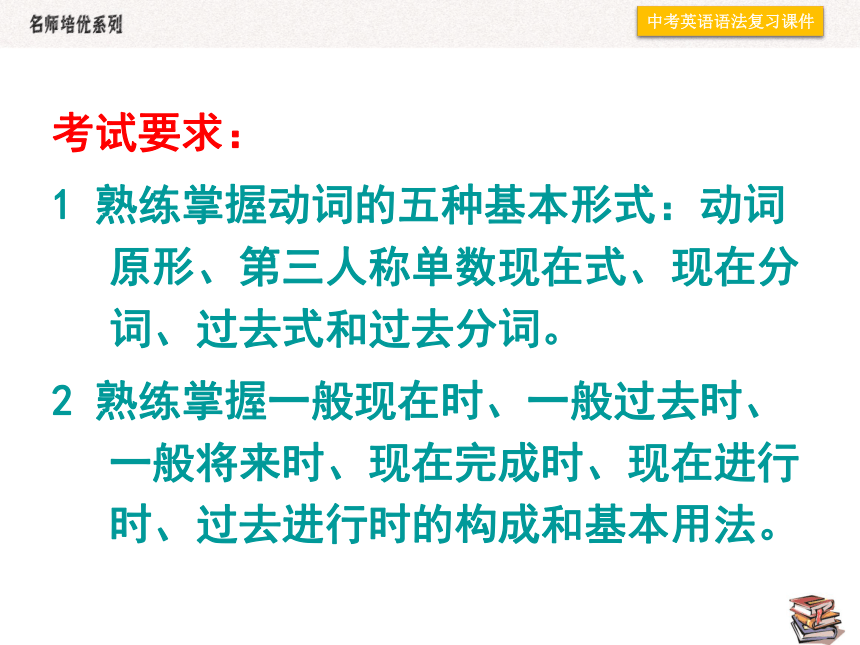
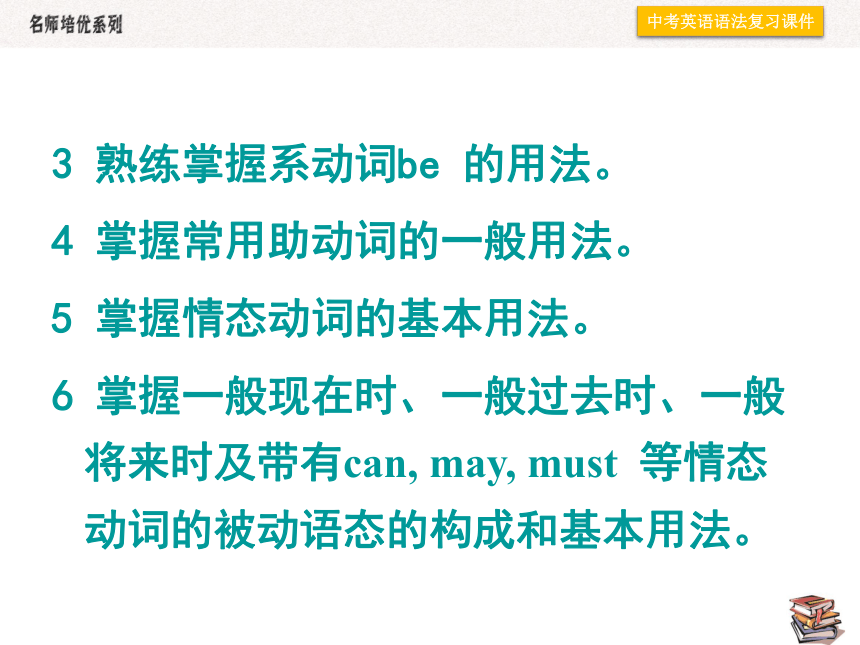

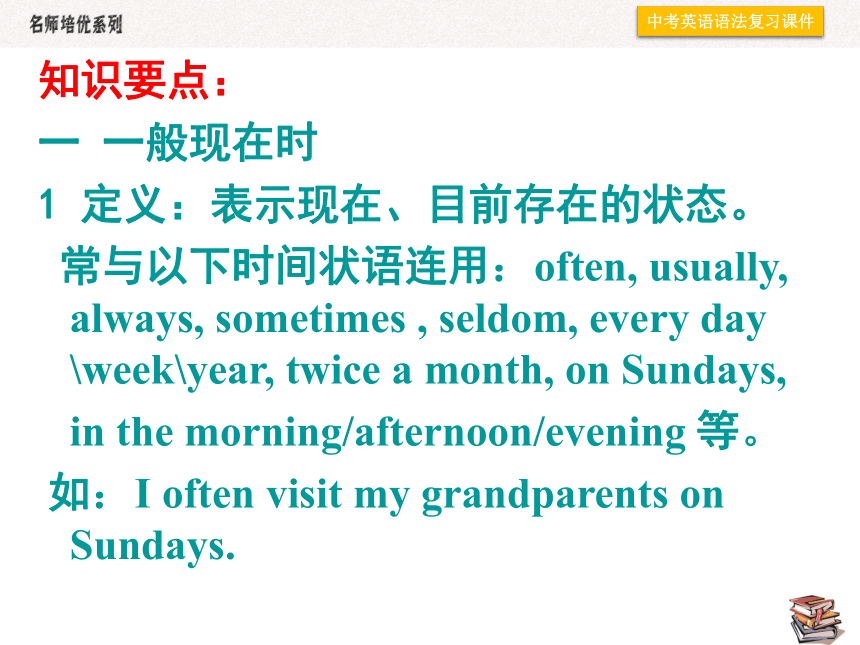

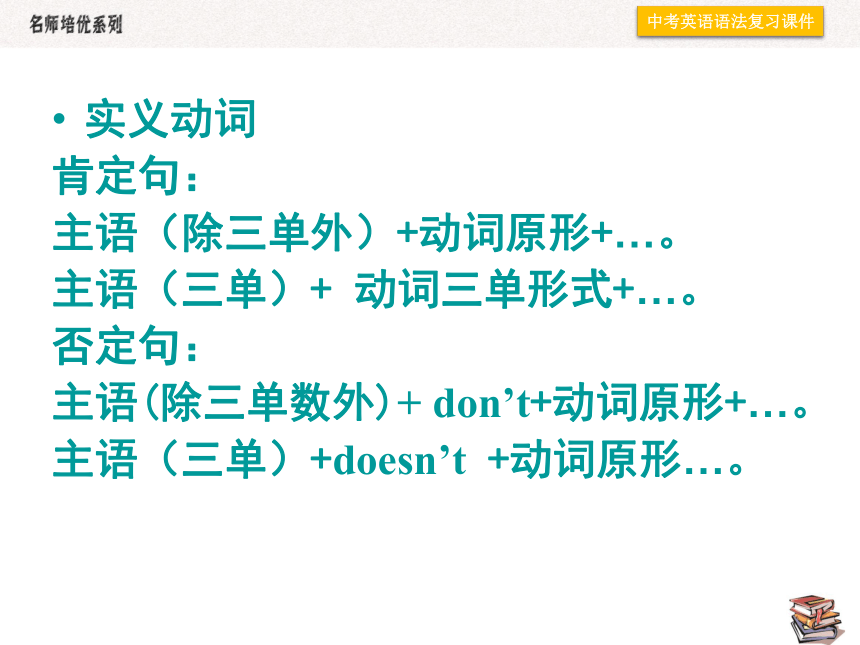
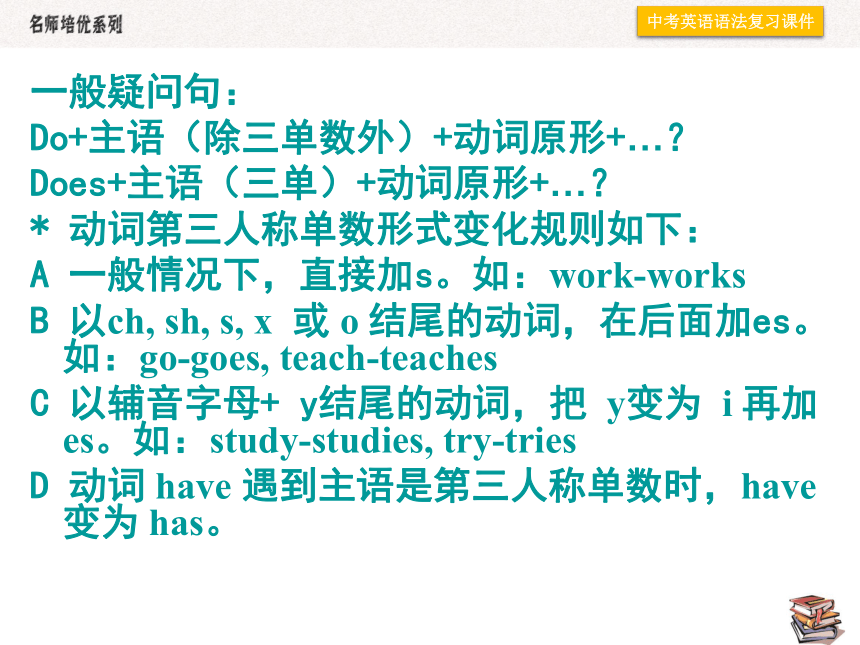
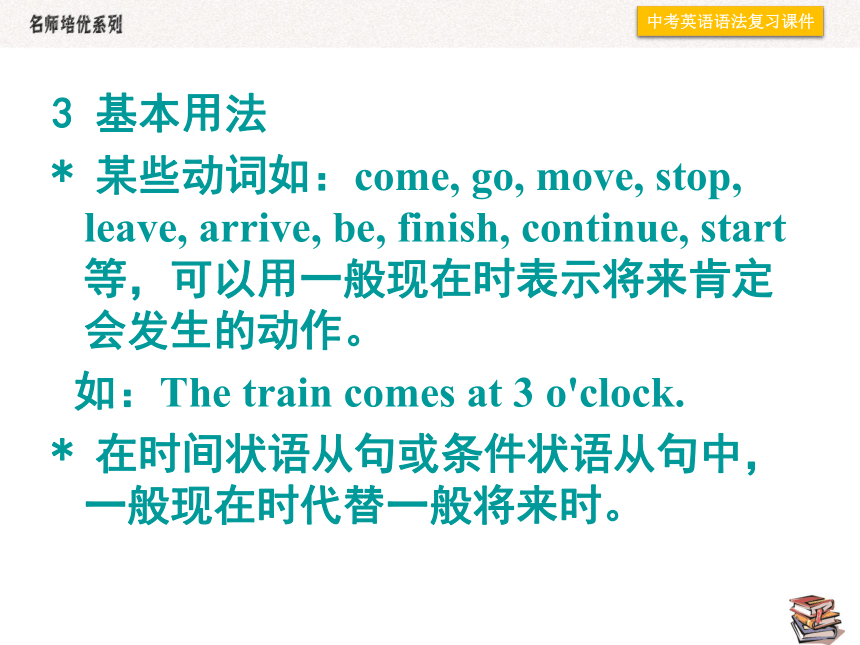
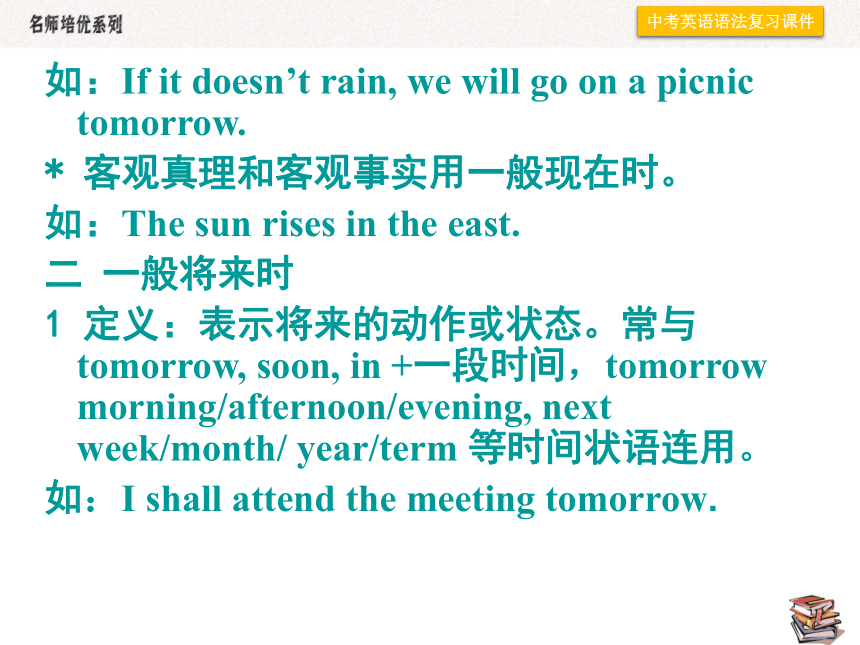
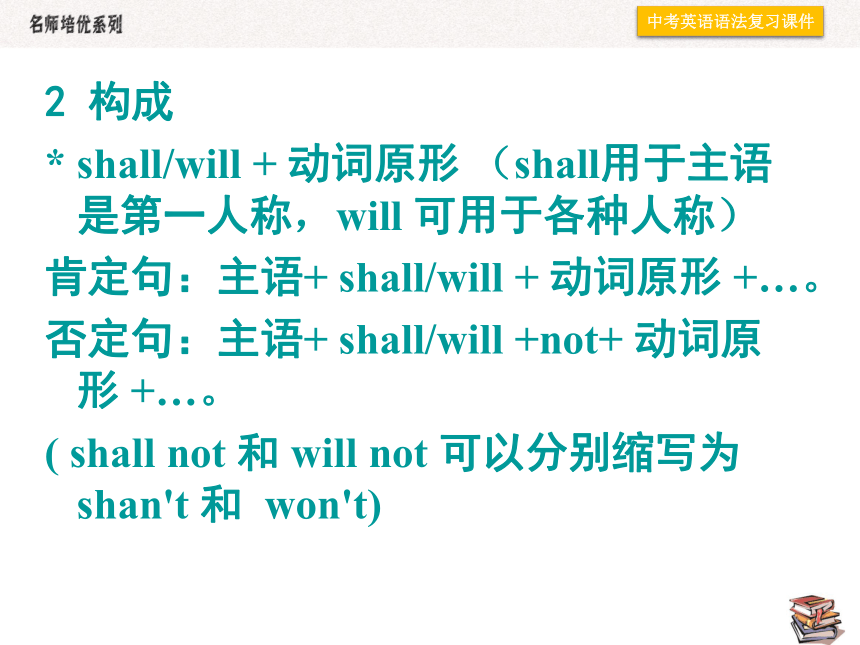
文档简介
(共52张PPT)
考试要求:
1 熟练掌握动词的五种基本形式:动词原形、第三人称单数现在式、现在分词、过去式和过去分词。
2 熟练掌握一般现在时、一般过去时、一般将来时、现在完成时、现在进行时、过去进行时的构成和基本用法。
3 熟练掌握系动词be 的用法。
4 掌握常用助动词的一般用法。
5 掌握情态动词的基本用法。
6 掌握一般现在时、一般过去时、一般将来时及带有can, may, must 等情态动词的被动语态的构成和基本用法。
7 掌握不定式作宾语、宾语补足语、状语以及和疑问词连用构成不定式短语的基本用法。
8 初步掌握become, get, look, turn 等系动词的一般用法。
9 初步掌握延续动词和瞬间动词在用法上的区别。
知识要点:
一 一般现在时
1 定义:表示现在、目前存在的状态。
常与以下时间状语连用:often, usually, always, sometimes , seldom, every day \week\year, twice a month, on Sundays,
in the morning/afternoon/evening 等。
如:I often visit my grandparents on Sundays.
2 构成
be( am ,is ,are)动词
肯定句:主语+be动词 +…。
否定句:主语+be动词 + not + …。
一般疑问句:Be动词 + 主语 + …?
特殊疑问句:疑问词+be动词+主语+…?
实义动词
肯定句:
主语(除三单外)+动词原形+…。
主语(三单)+ 动词三单形式+…。
否定句:
主语(除三单数外)+ don’t+动词原形+…。
主语(三单)+doesn’t +动词原形…。
一般疑问句:
Do+主语(除三单数外)+动词原形+…?
Does+主语(三单)+动词原形+…?
* 动词第三人称单数形式变化规则如下:
A 一般情况下,直接加s。如:work-works
B 以ch, sh, s, x 或 o 结尾的动词,在后面加es。 如:go-goes, teach-teaches
C 以辅音字母+ y结尾的动词,把 y变为 i 再加es。如:study-studies, try-tries
D 动词 have 遇到主语是第三人称单数时,have 变为 has。
3 基本用法
* 某些动词如:come, go, move, stop, leave, arrive, be, finish, continue, start 等,可以用一般现在时表示将来肯定会发生的动作。
如:The train comes at 3 o'clock.
* 在时间状语从句或条件状语从句中,一般现在时代替一般将来时。
如:If it doesn’t rain, we will go on a picnic tomorrow.
* 客观真理和客观事实用一般现在时。
如:The sun rises in the east.
二 一般将来时
1 定义:表示将来的动作或状态。常与 tomorrow, soon, in +一段时间,tomorrow morning/afternoon/evening, next week/month/ year/term 等时间状语连用。
如:I shall attend the meeting tomorrow.
2 构成
* shall/will + 动词原形 (shall用于主语是第一人称,will 可用于各种人称)
肯定句:主语+ shall/will + 动词原形 +…。
否定句:主语+ shall/will +not+ 动词原形 +…。
( shall not 和 will not 可以分别缩写为shan't 和 won't)
一般疑问句:Shall/Will+主语+ 动词原形 +…?
特殊疑问句:疑问词+ shall/will+主语+ 动词原形 +…?
* be going to +动词原形
肯定句:主语+ be(am, is, are ) going to + 动词原形 +…。
否定句:主语+ be(am, is, are) not going to + 动词原形 +…。
一般疑问句:Be (Am, Is, Are) +主语going to + 动词原形 +…?
特殊疑问句:疑问词+ be(am, is , are ) +
主语+going to + 动词原形 +…?
3 基本用法
* 表示将要发生的动作或存在的状态。
如:We shall finish the work before 5 o’clock.
* 用于一些主从复合句的主句中,表示将来的动作和状态。
如:I will help if he is in trouble.
* Shall/will 表示有礼貌的询问对方是否愿意或客气的邀请或命令。
如:Shall we meet at the school gate
Will you buy me some bananas
三 一般过去时
1 定义:表示过去的动作和状态。与
yesterday, last week/month, three days
ago, in 2008, in the past, just now,
when I was young 等词连用。
如:I met him yesterday.
2 构成
* be 动词
肯定句:主语+be 动词(was, were)+…。
否定句:主语+be 动词(was, were )+not+…。
一般疑问句:
Be动词(Was, Were)+主语+…?
特殊疑问句:
疑问词+be动词(was, were)+主语+…?
* 实义动词
肯定句:主语+动词过去式+…。
否定句:主语+ didn’t +动词原形+…。
一般疑问句:Did+主语+动词原形+…?
特殊疑问句:
疑问词+did+主语+动词原形+…?
* 动词过去式\过去分词的变化规则如下:
A 一般在动词原形后加ed,如:learn-learned
B 以 e 为结尾的动词,直接加d,
如:live-lived, use-used
C 以辅音字母加y 结尾的动词,先将y变成i再加ed, 如:carry-carried
D 以重读闭音节结尾且末尾只有一个辅音字母的动词,双写后再加ed。
如:stop-stopped, drop-dropped
3 基本用法
* 表示过去某一时间发生的动作或存在的状态。
如:Tom went to visit the Summer Palace last summer.
* 表示过去一段时间内经常或反复的动作。
如:When I was in Japan, I often traveled by car.
* 在现在完成时的句子中,由since 引导时间状语从句要用过去时。
如:We have learned 1000 English words since we studied at this school.
四 现在进行时
1 定义:表示现在正在进行的动作。与now, at the moment, at this time, at present, these days 等时间状语连用。
如:We are working now.
2 构成:
肯定句:
主语+be(am, is , are )+现在分词…。
否定句:
主语+be (am, is , are)+ not +现在分词…。
一般疑问句:
Be(Am, Is, Are)+主语+现在分词…?
特殊疑问句:疑问词+be(am, is, are)+主语+现在分词…?
3 现在分词的构成如下:
A 一般情况下,直接在动词原形后面加ing。如:go-going
B 以不发音的e结尾的动词,去e再加ing。
如:come-coming, take-taking
C 闭音节的单音节词,或重读闭音节结
尾的多音节词,末尾只有一个辅音字
母, 双写再加ing。如:sit-sitting
还有:put, run, get, stop, swim等动词。
4 基本用法
* 表示说话者说话时正在发生或者进行的动作。如:What are you doing now
* 表示目前一段时间内正在进行的动作,也许此时此刻这个动作并没有进行。
如:The students are preparing for the
examination these days.
* 某些动词的现在进行时可以表示即将发生的动作。
如:They are going to Hong Kong tomorrow.
* 以下动词不用现在进行时:
A 表示感觉的感官动词。
如:see, hear等。
B 表示态度、感情、心理状态等动词。如:like, love, know, hate, agree, believe等。
C 表示归属的动词。如:have 等。
五 过去进行时
1 定义:表示过去某一时刻或某一段时
间内正在进行的动作。常和表示过去的
时间状语词组或从句连用。
如:then, at nine last night, at this/that time, yesterday, when I got home等。
2 构成
肯定句:
主语+be(was, were)+现在分词…。
否定句:
主语+be(was, were)+not+现在分词…。
一般疑问句:
Be(Was, Were)+主语+现在分词…?
特殊疑问句:疑问词+be(was, were)+主语+现在分词…?
3 基本用法
* 表示过去某个时刻或某一阶段正在进行的动作。
如:It was raining heavily at nine last night.
* 用于when 或者while 引导的时间状语从句中。
如:My mother was cooking when I got home.
六 现在完成时
1 定义: 表示已经完成的动作发生在过去,但对现在造成影响。
如:I have finished my homework.
2 构成
肯定句:
主语(除三单外)+have +过去分词…。
主语(He/She/It…)+ has+过去分词+…。
否定句:
主语(除三单外)+have +not +过去分
词…。(have not=haven’t)
主语(He/She/It…)+ has +not +过去
词…。 (has not=hasn’t)
一般疑问句:
Have /Has +主语+过去分词+…?
3 基本用法
* 表示在说话之前已经完成或刚完成的动作。如:He has already left.
* 表示过去发生的事或已经完成的某一动作对现在造成的影响或结果。
如:They have found the lost boy.
* 表示动作从过去开始持续到现在,或者还有可能持续下去。与for 和 since 引导的短语或从句连用。动词要使用延续性动词。
如:We have lived here since 1976.
A 延续性动词表示动作是可持续的,可以和表示一段时间的状语连用。
如:He has been in Beijing for 2 weeks/
since 2 weeks ago.
B 瞬间动词表示动作一经发生便立即结束,不能和表示一段时间的状语连用,如果和表示一段时间的状语连用,要用其他词代替。
如:He borrowed the book two days ago. He has kept the book for two days.
瞬间动词与延续性动词的转换
buy have
borrow keep
begin/start be on
finish be over
die be dead
瞬间动词与延续性动词的转换
join be in +组织/be a member of+组织
leave be away from
come here be here
get up be up
arrive/reach be in
go be away
七 情态动词
1 can
* 表示能力,意为“能,会”。
如:I can speak French.
* 表示请求、允许,意为“可以”,相当于may。如:Can I sit here
* 表示怀疑、猜测,常用于否定句,意
为“一定不, 不可能”。
如:That man can’t be Tom’s father, his father is in Japan now.
* 以can开头的一般疑问句肯定和否定答
语要分别使用can和can’t。
如:—Can you speak Spanish
—Yes, I can. / No, I can’t.
2 may
* 表示请求、许可,意为“可以”。
如:May I come in
* 表示推测,用于肯定句,意为“可能,也许”。
如:Ask the policeman, he may know。
* 以may开头的一般疑问句,肯定回答用may, certainly, 或sure, 意为“可以”。否定回答用can’t, 用mustn’t意为“绝对不可以”。
如:— May I smoke here
— Yes, you may. /No, you mustn’t.
3 must
* 意为“必须,应该”。
如:You must walk on the left.
* 表示推测,一般指有把握的判断或推测,意为“一定,准是”。
如:The light is on, so there must be
somebody in the room.
* 以must开头的一般疑问句肯定答语用must, 意为“必须”,否定答语要用needn’t
或者don’t have to,意为“没有必要”。
如:—Must I hand in my homework now
—Yes, you must. /No, you needn’t.
4 need
* 意为“需要”。如:You need get up now.
* 以need 开头的一般疑问句肯定和否定答语分别要用need和needn’t。
如:—Need I speak Spanish
—Yes, you need. No, you needn’t.
八 系动词
1分类
* 状态系动词:只有be一词。如:My father is a doctor.
* 持续系动词:表示主语继续或保持一种状况或态度,主要有keep, stay等。
如:He always kept silent.
* 表像系动词:表示“看起来好像”,主要有seem, look等。
如:He looks tired.
He seems (to be) quite happy.
* 感官系动词:表示“……起来”,有:feel(摸起来,感觉) , smell(闻起来) , sound(听起来) , taste(尝起来,吃起来) 等。 如:Ice feels cold.
* 变化系动词:表示 “主语变成什么样”,主要有become, turn, go, get等。
如:The leaves turn yellow in autumn.
2 辨析
* become 较get 正式。两者均指人的感情、身体状况、自然和社会的变化。常和become 连用的形容词有:clear, cloudy, famous, ill 等。常和get 连用的词有:used to, worse, better, tired, dark等。
* go 常用于指负面(不好的)变化。 常与go 连用的形容词有:wrong, bad, crazy, blind等。
* turn 常常与颜色连用,意为“变成…色”。
如:turn red, turn yellow
九 动词不定式
不定式的基本形式是“to +动词原形”,否定形式是“not+to+动词原形”。有的动词不定式可以不带to。动词不定式没有人称和数的变化,在句子中可以担任除谓语以外的任何成份。
1 不定式作宾语
* 不定式在及物动词后做宾语。
如:hope to+动词原形。
* 常见的加不定式做宾语的及物动词有:afford 负担得起,agree 同意,choose 决定,decide 决定,expect 期待,fail未能,help 帮助,hope 希望,offer 主动提出,plan 计划,prepare 准备,promise 答应,refuse 拒绝,wish 希望,begin 开始,learn学习,want 想要
如:—What does Tom promise to do
—He wants us to get up early, so he
promises to buy us am alarm clock.
* 在think, find后不定式做宾语时,常用it 代替,而将真正的宾语放在句末。
如:He finds it hard to drive a car.
2 不定式作宾语补足语
* 不定式作宾补时与宾语有逻辑上的关系。形式如下:tell sb. to +动词原形。
* 后接不定式作宾补的及物动词有:want, ask, tell, advise, allow, teach, order, help, persuade, encourage, would like 等。
如:Who taught you to drive
* 使役动词make, let, have 和感官动词see, hear等后也可以跟不定式作宾语,但是要省略to。
如:The boss makes the workers work for
ten hours a day.
* 不定式作宾补的否定形式如下:
tell sb. not to +动词原形
如:My father often tells me not to stay outside after school.
3 不定式作状语
不定式作状语可以表示多种关系。有:目的、结果、原因、条件等。
如:I went to France to learn French. (目的)
He returned home to find his wife
waiting for him. (表结果)
4 不定式常和疑问词what, which, when, where, how 连用。
如:He didn’t know where to go.
十 被动语态
1 被动语态的构成:
* 一般现在时被动语态:主语+am/is/are +过去分词(+by sb….)。
如:English is spoken by more and more
people now.
* 一般过去时被动语态:主语+was/were +过去分词(+by sb….)。
如:The book was written by LuXun.
* 一般将来时被动语态:
主语+will/shall +be+过去分词(+by sb…)。
主语+am/is/are going to +be+过去分词(+by sb….)。
如:The gift will be given to the girl.
The book is going to be given to the girl.
* 含有情态动词的被动语态:主语+can/may/must +be +过去分词(+by sb…)。
如:The computer can’t be put in the sun.
2 被动语态的基本用法
* 不知道动作的执行者。
如:Printing was introduced into Europe from China.
* 没有必要指出动作的执行者。
如:Trees should be planted to stop the wind.
* 强调和侧重动作的承受者。
如:The boy was saved at last.
* 有些动词习惯上常用被动语态。
如:I was born in 1973.
考试要求:
1 熟练掌握动词的五种基本形式:动词原形、第三人称单数现在式、现在分词、过去式和过去分词。
2 熟练掌握一般现在时、一般过去时、一般将来时、现在完成时、现在进行时、过去进行时的构成和基本用法。
3 熟练掌握系动词be 的用法。
4 掌握常用助动词的一般用法。
5 掌握情态动词的基本用法。
6 掌握一般现在时、一般过去时、一般将来时及带有can, may, must 等情态动词的被动语态的构成和基本用法。
7 掌握不定式作宾语、宾语补足语、状语以及和疑问词连用构成不定式短语的基本用法。
8 初步掌握become, get, look, turn 等系动词的一般用法。
9 初步掌握延续动词和瞬间动词在用法上的区别。
知识要点:
一 一般现在时
1 定义:表示现在、目前存在的状态。
常与以下时间状语连用:often, usually, always, sometimes , seldom, every day \week\year, twice a month, on Sundays,
in the morning/afternoon/evening 等。
如:I often visit my grandparents on Sundays.
2 构成
be( am ,is ,are)动词
肯定句:主语+be动词 +…。
否定句:主语+be动词 + not + …。
一般疑问句:Be动词 + 主语 + …?
特殊疑问句:疑问词+be动词+主语+…?
实义动词
肯定句:
主语(除三单外)+动词原形+…。
主语(三单)+ 动词三单形式+…。
否定句:
主语(除三单数外)+ don’t+动词原形+…。
主语(三单)+doesn’t +动词原形…。
一般疑问句:
Do+主语(除三单数外)+动词原形+…?
Does+主语(三单)+动词原形+…?
* 动词第三人称单数形式变化规则如下:
A 一般情况下,直接加s。如:work-works
B 以ch, sh, s, x 或 o 结尾的动词,在后面加es。 如:go-goes, teach-teaches
C 以辅音字母+ y结尾的动词,把 y变为 i 再加es。如:study-studies, try-tries
D 动词 have 遇到主语是第三人称单数时,have 变为 has。
3 基本用法
* 某些动词如:come, go, move, stop, leave, arrive, be, finish, continue, start 等,可以用一般现在时表示将来肯定会发生的动作。
如:The train comes at 3 o'clock.
* 在时间状语从句或条件状语从句中,一般现在时代替一般将来时。
如:If it doesn’t rain, we will go on a picnic tomorrow.
* 客观真理和客观事实用一般现在时。
如:The sun rises in the east.
二 一般将来时
1 定义:表示将来的动作或状态。常与 tomorrow, soon, in +一段时间,tomorrow morning/afternoon/evening, next week/month/ year/term 等时间状语连用。
如:I shall attend the meeting tomorrow.
2 构成
* shall/will + 动词原形 (shall用于主语是第一人称,will 可用于各种人称)
肯定句:主语+ shall/will + 动词原形 +…。
否定句:主语+ shall/will +not+ 动词原形 +…。
( shall not 和 will not 可以分别缩写为shan't 和 won't)
一般疑问句:Shall/Will+主语+ 动词原形 +…?
特殊疑问句:疑问词+ shall/will+主语+ 动词原形 +…?
* be going to +动词原形
肯定句:主语+ be(am, is, are ) going to + 动词原形 +…。
否定句:主语+ be(am, is, are) not going to + 动词原形 +…。
一般疑问句:Be (Am, Is, Are) +主语going to + 动词原形 +…?
特殊疑问句:疑问词+ be(am, is , are ) +
主语+going to + 动词原形 +…?
3 基本用法
* 表示将要发生的动作或存在的状态。
如:We shall finish the work before 5 o’clock.
* 用于一些主从复合句的主句中,表示将来的动作和状态。
如:I will help if he is in trouble.
* Shall/will 表示有礼貌的询问对方是否愿意或客气的邀请或命令。
如:Shall we meet at the school gate
Will you buy me some bananas
三 一般过去时
1 定义:表示过去的动作和状态。与
yesterday, last week/month, three days
ago, in 2008, in the past, just now,
when I was young 等词连用。
如:I met him yesterday.
2 构成
* be 动词
肯定句:主语+be 动词(was, were)+…。
否定句:主语+be 动词(was, were )+not+…。
一般疑问句:
Be动词(Was, Were)+主语+…?
特殊疑问句:
疑问词+be动词(was, were)+主语+…?
* 实义动词
肯定句:主语+动词过去式+…。
否定句:主语+ didn’t +动词原形+…。
一般疑问句:Did+主语+动词原形+…?
特殊疑问句:
疑问词+did+主语+动词原形+…?
* 动词过去式\过去分词的变化规则如下:
A 一般在动词原形后加ed,如:learn-learned
B 以 e 为结尾的动词,直接加d,
如:live-lived, use-used
C 以辅音字母加y 结尾的动词,先将y变成i再加ed, 如:carry-carried
D 以重读闭音节结尾且末尾只有一个辅音字母的动词,双写后再加ed。
如:stop-stopped, drop-dropped
3 基本用法
* 表示过去某一时间发生的动作或存在的状态。
如:Tom went to visit the Summer Palace last summer.
* 表示过去一段时间内经常或反复的动作。
如:When I was in Japan, I often traveled by car.
* 在现在完成时的句子中,由since 引导时间状语从句要用过去时。
如:We have learned 1000 English words since we studied at this school.
四 现在进行时
1 定义:表示现在正在进行的动作。与now, at the moment, at this time, at present, these days 等时间状语连用。
如:We are working now.
2 构成:
肯定句:
主语+be(am, is , are )+现在分词…。
否定句:
主语+be (am, is , are)+ not +现在分词…。
一般疑问句:
Be(Am, Is, Are)+主语+现在分词…?
特殊疑问句:疑问词+be(am, is, are)+主语+现在分词…?
3 现在分词的构成如下:
A 一般情况下,直接在动词原形后面加ing。如:go-going
B 以不发音的e结尾的动词,去e再加ing。
如:come-coming, take-taking
C 闭音节的单音节词,或重读闭音节结
尾的多音节词,末尾只有一个辅音字
母, 双写再加ing。如:sit-sitting
还有:put, run, get, stop, swim等动词。
4 基本用法
* 表示说话者说话时正在发生或者进行的动作。如:What are you doing now
* 表示目前一段时间内正在进行的动作,也许此时此刻这个动作并没有进行。
如:The students are preparing for the
examination these days.
* 某些动词的现在进行时可以表示即将发生的动作。
如:They are going to Hong Kong tomorrow.
* 以下动词不用现在进行时:
A 表示感觉的感官动词。
如:see, hear等。
B 表示态度、感情、心理状态等动词。如:like, love, know, hate, agree, believe等。
C 表示归属的动词。如:have 等。
五 过去进行时
1 定义:表示过去某一时刻或某一段时
间内正在进行的动作。常和表示过去的
时间状语词组或从句连用。
如:then, at nine last night, at this/that time, yesterday, when I got home等。
2 构成
肯定句:
主语+be(was, were)+现在分词…。
否定句:
主语+be(was, were)+not+现在分词…。
一般疑问句:
Be(Was, Were)+主语+现在分词…?
特殊疑问句:疑问词+be(was, were)+主语+现在分词…?
3 基本用法
* 表示过去某个时刻或某一阶段正在进行的动作。
如:It was raining heavily at nine last night.
* 用于when 或者while 引导的时间状语从句中。
如:My mother was cooking when I got home.
六 现在完成时
1 定义: 表示已经完成的动作发生在过去,但对现在造成影响。
如:I have finished my homework.
2 构成
肯定句:
主语(除三单外)+have +过去分词…。
主语(He/She/It…)+ has+过去分词+…。
否定句:
主语(除三单外)+have +not +过去分
词…。(have not=haven’t)
主语(He/She/It…)+ has +not +过去
词…。 (has not=hasn’t)
一般疑问句:
Have /Has +主语+过去分词+…?
3 基本用法
* 表示在说话之前已经完成或刚完成的动作。如:He has already left.
* 表示过去发生的事或已经完成的某一动作对现在造成的影响或结果。
如:They have found the lost boy.
* 表示动作从过去开始持续到现在,或者还有可能持续下去。与for 和 since 引导的短语或从句连用。动词要使用延续性动词。
如:We have lived here since 1976.
A 延续性动词表示动作是可持续的,可以和表示一段时间的状语连用。
如:He has been in Beijing for 2 weeks/
since 2 weeks ago.
B 瞬间动词表示动作一经发生便立即结束,不能和表示一段时间的状语连用,如果和表示一段时间的状语连用,要用其他词代替。
如:He borrowed the book two days ago. He has kept the book for two days.
瞬间动词与延续性动词的转换
buy have
borrow keep
begin/start be on
finish be over
die be dead
瞬间动词与延续性动词的转换
join be in +组织/be a member of+组织
leave be away from
come here be here
get up be up
arrive/reach be in
go be away
七 情态动词
1 can
* 表示能力,意为“能,会”。
如:I can speak French.
* 表示请求、允许,意为“可以”,相当于may。如:Can I sit here
* 表示怀疑、猜测,常用于否定句,意
为“一定不, 不可能”。
如:That man can’t be Tom’s father, his father is in Japan now.
* 以can开头的一般疑问句肯定和否定答
语要分别使用can和can’t。
如:—Can you speak Spanish
—Yes, I can. / No, I can’t.
2 may
* 表示请求、许可,意为“可以”。
如:May I come in
* 表示推测,用于肯定句,意为“可能,也许”。
如:Ask the policeman, he may know。
* 以may开头的一般疑问句,肯定回答用may, certainly, 或sure, 意为“可以”。否定回答用can’t, 用mustn’t意为“绝对不可以”。
如:— May I smoke here
— Yes, you may. /No, you mustn’t.
3 must
* 意为“必须,应该”。
如:You must walk on the left.
* 表示推测,一般指有把握的判断或推测,意为“一定,准是”。
如:The light is on, so there must be
somebody in the room.
* 以must开头的一般疑问句肯定答语用must, 意为“必须”,否定答语要用needn’t
或者don’t have to,意为“没有必要”。
如:—Must I hand in my homework now
—Yes, you must. /No, you needn’t.
4 need
* 意为“需要”。如:You need get up now.
* 以need 开头的一般疑问句肯定和否定答语分别要用need和needn’t。
如:—Need I speak Spanish
—Yes, you need. No, you needn’t.
八 系动词
1分类
* 状态系动词:只有be一词。如:My father is a doctor.
* 持续系动词:表示主语继续或保持一种状况或态度,主要有keep, stay等。
如:He always kept silent.
* 表像系动词:表示“看起来好像”,主要有seem, look等。
如:He looks tired.
He seems (to be) quite happy.
* 感官系动词:表示“……起来”,有:feel(摸起来,感觉) , smell(闻起来) , sound(听起来) , taste(尝起来,吃起来) 等。 如:Ice feels cold.
* 变化系动词:表示 “主语变成什么样”,主要有become, turn, go, get等。
如:The leaves turn yellow in autumn.
2 辨析
* become 较get 正式。两者均指人的感情、身体状况、自然和社会的变化。常和become 连用的形容词有:clear, cloudy, famous, ill 等。常和get 连用的词有:used to, worse, better, tired, dark等。
* go 常用于指负面(不好的)变化。 常与go 连用的形容词有:wrong, bad, crazy, blind等。
* turn 常常与颜色连用,意为“变成…色”。
如:turn red, turn yellow
九 动词不定式
不定式的基本形式是“to +动词原形”,否定形式是“not+to+动词原形”。有的动词不定式可以不带to。动词不定式没有人称和数的变化,在句子中可以担任除谓语以外的任何成份。
1 不定式作宾语
* 不定式在及物动词后做宾语。
如:hope to+动词原形。
* 常见的加不定式做宾语的及物动词有:afford 负担得起,agree 同意,choose 决定,decide 决定,expect 期待,fail未能,help 帮助,hope 希望,offer 主动提出,plan 计划,prepare 准备,promise 答应,refuse 拒绝,wish 希望,begin 开始,learn学习,want 想要
如:—What does Tom promise to do
—He wants us to get up early, so he
promises to buy us am alarm clock.
* 在think, find后不定式做宾语时,常用it 代替,而将真正的宾语放在句末。
如:He finds it hard to drive a car.
2 不定式作宾语补足语
* 不定式作宾补时与宾语有逻辑上的关系。形式如下:tell sb. to +动词原形。
* 后接不定式作宾补的及物动词有:want, ask, tell, advise, allow, teach, order, help, persuade, encourage, would like 等。
如:Who taught you to drive
* 使役动词make, let, have 和感官动词see, hear等后也可以跟不定式作宾语,但是要省略to。
如:The boss makes the workers work for
ten hours a day.
* 不定式作宾补的否定形式如下:
tell sb. not to +动词原形
如:My father often tells me not to stay outside after school.
3 不定式作状语
不定式作状语可以表示多种关系。有:目的、结果、原因、条件等。
如:I went to France to learn French. (目的)
He returned home to find his wife
waiting for him. (表结果)
4 不定式常和疑问词what, which, when, where, how 连用。
如:He didn’t know where to go.
十 被动语态
1 被动语态的构成:
* 一般现在时被动语态:主语+am/is/are +过去分词(+by sb….)。
如:English is spoken by more and more
people now.
* 一般过去时被动语态:主语+was/were +过去分词(+by sb….)。
如:The book was written by LuXun.
* 一般将来时被动语态:
主语+will/shall +be+过去分词(+by sb…)。
主语+am/is/are going to +be+过去分词(+by sb….)。
如:The gift will be given to the girl.
The book is going to be given to the girl.
* 含有情态动词的被动语态:主语+can/may/must +be +过去分词(+by sb…)。
如:The computer can’t be put in the sun.
2 被动语态的基本用法
* 不知道动作的执行者。
如:Printing was introduced into Europe from China.
* 没有必要指出动作的执行者。
如:Trees should be planted to stop the wind.
* 强调和侧重动作的承受者。
如:The boy was saved at last.
* 有些动词习惯上常用被动语态。
如:I was born in 1973.
同课章节目录
- 词法
- 名词
- 动词和动词短语
- 动词语态
- 动词时态
- 助动词和情态动词
- 非谓语动词
- 冠词
- 代词
- 数词和量词
- 形容词副词及其比较等级
- 介词和介词短语
- 连词和感叹词
- 构词法
- 相似、相近词比较
- 句法
- 陈述句
- 一般疑问句和否定疑问句
- 特殊疑问句及选择疑问句
- 反意疑问句
- 存在句(There be句型)
- 宾语从句
- 定语从句
- 状语从句
- 主谓一致问题
- 简单句
- 并列句
- 复合句
- 主谓一致
- 主、表语从句
- 名词性从句
- 直接引语和间接引语
- 虚拟语气
- 感叹句
- 强调句
- 倒装句
- 祈使句
- 句子的成分
- 句子的分类
- 题型专区
- 单项选择部分
- 易错题
- 完形填空
- 阅读理解
- 词汇练习
- 听说训练
- 句型转换
- 补全对话
- 短文改错
- 翻译
- 书面表达
- 任务型阅读
- 语法填空
- 其他资料
